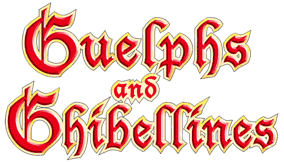|
Game
Description
Guelphs and Ghibellines drives you
through the art of warfare in XIIIth century Italy. The game captures at a tactical
level the climax of the long struggle for the predominance of Italy during this century. After the
death of the German Emperor Frederick II, the struggle extended for the predominance of the most
important cities in Tuscany, passed through the death of Manfred in the battle
of Benevento, which marks the end of the Swabian dominium in Italy and the
take-over of the Angioin dynasty over the Reign of Naples, and finally the
defeat of the last Ghibelline cities
in Tuscany at Campaldino.
Guelphs and Ghibellines simulates the traditional clashes between
XIIIth century armies with an original system which is both simple and
accurate, allowing to reproduce typical tactics of the battle of the era, and
focusing on progressive combat fatigue and loss of cohesion of formations on
the battlefield. Cavalry remains the Queen of the battlefield, but the Italian
communal infantry (the best in its period) manages to have a sound impact on
the outcome of the fight.
All the main protagonists of the battles and all the different types of
troops are considered, included cavalry with various level of armour
protection, infantry, archers, crossbowmen, palvesari, the Comunal Carroccio,
etc.
The Battles
Montaperti 1260: The Arbia colored in red. The battle of Montaperti, one of
the biggest battles in the Italian Middle Ages, was fought on Sept
4th, 1260 near Siena between the troops of the
Siena-leaded Ghibelline coalition and
those of the Guelphe alliance, under the command of Florence. In the
first hours of the morning, the Ghibelline army, inferior in numbers, crossed
the river Arbia taking the Guelphes by surprise, which did not expect to fight
just on that day. The fight began when the Ghibelline cavalry, mainly composed
of German cavalrymen, attacked the Guelphe cavalry, deployed on the right
flank, generating a furious melee. Soon after the Senese infantry attacked the
Guelphes too and the fight generally spread over the battlefield. The formation
of the Earl of Arras made an encirclement manoeuvre and then attacked the Florentines
in the flank: this was decisive. The same Arras killed the Florence leader Iacopino Rangoni da Modena and so the Guelphes began to fly. The Ghibellines started to pursue and
began the great carnage which turned the Arbia in red ("lo strazio e 'l
grande scempio che fece l'Arbia colorata in rosso", Dante, Divina Commedia, Inf. X, 84-85) and lasted until night. Losses are
estimated as 10,000 casualties and just as many prisoners for the Guelphes,
while only 600 casualties and 400 wounded for the Ghibellines.
Benevento 1266: The twilight of
the Hoenstaufen. Following
the crusade banned by pope Clement IV against Manfred, king of Sicily, a French army commanded by Charles
of Anjou invaded Italy. The decisive battle took place in Benevento, Feb 25th,
1266. The
battle began in the morning with a saracen archers attack which repulsed
Charles’s infantry; but soon a decisive charge of the French heavy cavalry defeated
the enemy infantry. The first wave of Manfred’s cavalry charged too and the
fight easily spread all over the cavalry formations: mostly due to the Swabian
greater difficulties in manoeuvring (the river Calore was probably a major
impediment for them) , soon the course of the battle revealed unfavourable for
Manfred. The victory of Charles of Anjou marked the beginning of the Angioin dynasty
in Italy. Manfred being defeated and killed on the
battlefield, the Swabian power crushes and the Ghibelline party in Italy is definitively compromised for
many years to come.
Campaldino 1289: The
Saturday of St. Barnaba. The Guelphe army, mainly composed of Florentine troops and commanded by
the angioin Amerigo of Nerbon, and the army composed of Arezzo (the last Ghibelline power in Tuscany) troops and other many Ghibelline
lords of Central
Italy, commanded by the Bishop of Arezzo Guglielmino
degli Umbertini, clashed again in the plan of Campaldino, Saturday,
June 11th 1289. The initial charge of the Ghibelline feditori, shouting "San
Donato Cavaliere!", patron of Arezzo, compelled the Guelphe formation to
set back, but the Arezzo troops, even if deeply penetrating
into the enemy rows, did not manage in shattering them and remained trapped
between two wings of Guelphs skirmishers. In the meanwhile, the Florentine
Corso Donati, commanding the Gueplhe reserve cavalry of Pistoia and Lucca, rejecting his orders to maintain
his position, made his mind to attack the enemy lines engaged in the melee. The
Ghibelline cavalrymen so found themselves completely encircled and were totally
routed. Among the many personalities who lost their lives in the plan of Campaldino,
there were Guillaume Bertrand de Durfort, an old
veteran of Charles I, and two illustrious Ghibelline captains: Buonconte
da Montefeltro and the warrior bishop Guglielmino degli Ubertini, which is
still buried in the near church of Certomondo.
Game
system
The game is based on a continuous sequence of activations of formation
leaders on the battlefield, limited by their intrinsic command capacity and the
battle fatigue. The traditional sequence of play is replaced by uninterrupted
sequence of activations where each leader trying to bring victory to his side.
However the exact sequence of activation of friendly troops is unpredictable,
that makes the game difficult to master and always uncertain. The game system
is relatively simple, but the different tactics of the era are rendered in an
elegant way; cavalry against cavalry or against infantry, effect of missiles,
etc. Even the main personalities (and heroes) which enlightened those climatic
days are present on the battle map.
G&G Home
Page
|
